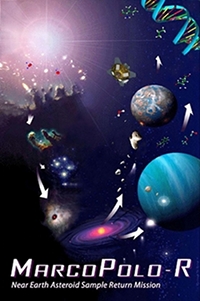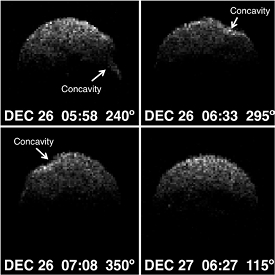Science Goals
 |
|
Artistic concept of the MarcoPolo-R mission. Credit: ESA |
In contrast to the planets, most asteroids and (dormant) comets, have experienced less internal heating primarily due to their smaller size. As a result, they are believed to have retained a 'record' of the original composition of our Solar System's protoplanetary disc, and in some cases even retain material that pre-dates the Solar System. This material contains evidence for interstellar processes and its formation in late-type stars. Asteroids and their primitive constituents offer clues to the chemical mixture from which the planets formed roughly 4.6 billion years ago.
Theories that propose exobiological origins for terrestrial life suggest that organic matter was delivered from space. Small, primitive bodies abundant in the Solar System are primary planetary impactors. This makes them strong candidates for the type of objects that may have brought water and complex organic molecules to Earth, eventually triggering prebiotic synthesis of biochemical compounds on early Earth. Thus, in studying our Solar System's history, small bodies provide a unique tool to investigate both the formation of the planets and the origin of life. Asteroids are also a potentially rich resource for future space exploration, whilst the possibility of an asteroid colliding with Earth poses a hazard to life on our planet. These are some of the reasons for why the exploration of near-Earth asteroids (NEAs) is especially interesting and timely.
Sample return
Studying meteorites that have impacted the Earth is informative, but has limitations compared to studying a returned sample. Unlike NEAs, meteorites are not necessarily composed of pristine, primitive material. The primitive material ideal for study is friable and would not survive atmospheric entry in any appreciable amount.
The direct investigation of both the regolith of an asteroid and fresh interior fragments is only possible by means of a sample return mission. The small asteroid sample brought back to Earth by the Japan Aerospace Exploration Agency's Hayabusa mission has been confirmed to originate from a highly processed – and hence not primitive – S-type asteroid.
 |
|
The ultimate aim of MarcoPolo-R is to return a sample of asteroid dust. Credit: ESA |
MarcoPolo-R will provide access to the most primitive material available for studying the formation of the early Solar System by returning unaltered material from a near-Earth asteroid for detailed analysis in ground-based laboratories. The target asteroid (the primitive C-type object 2008 EV5) has a spectrum very similar to the Orgueil meteorite, which is known to be one of the most primitive meteorites on Earth (see Reddy et al., 2012). Radar observations are also available and a shape model was derived from these (see Busch et al., 2011).
Science objectives
The science objectives of the MarcoPolo-R mission have been defined to help fill the gaps in our knowledge and understanding of NEAs, of the history of the Solar System, and of potential Earth impactors. These key questions are:
- What were the processes occurring in the early Solar System and accompanying planet formation?
- What are the physical properties and evolution of the building blocks of terrestrial planets?
- Do NEAs of primitive classes contain pre-solar material yet unknown in meteoritic samples?
- What are the nature and the origins of organic material in primitive asteroids and how can they shed light on the origin of the molecules that are necessary for life?
Answers to these fundamental questions require measurements with exceptionally high precision and sensitivity. Such measurements cannot be performed by robotic spacecraft and experiments controlled remotely. For these reasons, it is necessary to return a sample to terrestrial laboratories which, in contrast to space payloads, are relatively unconstrained by mass, power, stability and availability. The most demanding measurements are those required to date the major events in the history of a sample, and determining its organic constituents.
Target asteroid
 |
|
Radar observations of 2008 EV5, the target asteroid for the MarcoPolo-R mission. Credit: Busch et al., 2011. |
A primitive asteroid is considered to be a low-albedo object of spectral class B, C, D, P or T including sub-classes. In the initial proposal, the primitive C-type binary 1996 FG3 had been chosen as the baseline target of MarcoPolo-R. Early in the industrial study it was realized that asteroid 2008 EV5, initially on the backup target list, was much easier to reach. Ground-based observational data became available more recently and after detailed assessment it was concluded that this asteroid is scientifically extremely interesting due to its highly primitive nature. Asteroid 2008 EV5 is now the baseline target.
The physical properties of asteroid 2008 EV5, estimated from ground-based observations, are given in the table below (based on Busch et al., 2011).
|
Physical properties of asteroid 2008 EV5 |
|
| Dimensions | (0.42 x 0.41 x 0.39) ± 0.05 km3 |
| Geometric albedo: | 0.12 ± 0.04 |
| Spin period: | 3.725 ± 0.001 hrs |
| Taxonomic type: | C |
